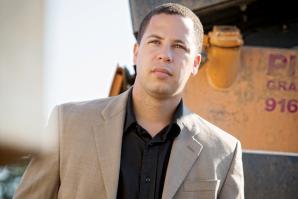John Frisch, 61, is regional managing director for Cornish & Carey Commercial Newmark Knight Frank. He is also the immediate past chair of the Sacramento Metro Chamber board of directors.
“When I started my commercial real estate career in 1982, I didn’t realize the market was bad. It was the era of very high interest rates, but there was plenty of money available. So I was out knocking on doors trying to make deals.”
“Some of the toughest years were 1992 to ’96. The region’s mantra was ‘stay alive til ’95.’ But nothing really started to turn around until ’96. In hindsight, that was child’s play compared to what we’re going through now. In my career, this is the fifth economic hiccup or upheaval I’ve experienced. They seem to be coming closer together.”
“We currently have an office vacancy rate of 23 percent in Sacramento, which means at the current rate of absorption, we have a 20-plus-year supply of office space. For the past five years, we have had a negative absorption rate. With some of the big deals that have already been made, we’re hoping to change that trend this year.”
“There is no reason to build new, private-sector office space at this time. In our heyday, the region was leasing 1 million to 1.5 million square feet of office space a year and building 1.5 to 2 million square feet a year. For the past six years, there really hasn’t been anything new built, and yet we’re still not gaining any ground on the vacancy front.”
“The south Placer County market is recovering much faster than the Sacramento market. If you look at the number of deals being made on Douglas Boulevard (Roseville) versus the Capitol Mall, it’s a hands-down victory. Of course they have more buildings and space out there; there’s more activity and more money in Roseville.”
“I ask myself, ‘Who are these people?’ when I visit The Fountains shopping center. Most of them are beautiful, they’re driving gorgeous cars, they’re carrying shopping bags and they seem to be very happy. The answer is, they live in Granite Bay or elsewhere in that little corner of South Placer. It’s just so different than I’m used to seeing in most malls in Sacramento.”
Tracy and Lathrop now dominate Northern California’s industrial distribution market. Those two cities have positioned themselves well with the incredible business growth being experienced in the Bay Area. All the big industrial deals are going there now. The industrial market in Sacramento just doesn’t change much from year to year. The last time any class-A industrial was built in this area was probably in the late ’90s. That’s when Woodland took off. But that growth has since been spurned by a 100-year floodplain designation.”
“Things have been going so well in the Bay Area for the past four years that they’re already starting to worry about the next crash. After the dot-com crash it was predicted that the Silicon Valley had 25 years of office and [research and development] space available. It was gone in five years. That’s a market where dynamic changes happen very fast. Very little like that happens in Sacramento.”
“Over the years, we’ve learned that there is a world of difference between Sacramento and the Bay Area. It’s not just us though; cities like Boston, Chicago and Dallas don’t have the creativity and capital to attract the talent pool they have. And while we can offer less expensive land and leases for office space, they don’t care. Those companies generate so much money that cheaper real estate is just budget dust.”
“From a business perspective, California is almost a Dr. Jekyll and Mr. Hyde. My personal opinion is that there’s no better place to live, work and play than in California. I think most of us feel that way. But damn, the state makes it difficult. I can’t imagine how prosperous this state would be if the business community wasn’t so overburdened with regulations and taxes.”
“You have to be in business to really understand how these regulations make it difficult for a small business to succeed. If you’re not in business, it’s just news stories. When you’re in business, you see first hand how things like [the Americans with Disabilities Act], 8-hour work days, minimum wage and maternity leave mandates affect a small business.It’s profound.”
“Land sales and retail were the first two things that went into the tank when the commercial real estate market took a dive at the end of 2007. Actually, the office and industrial markets were still very normal through 2008. But nobody was buying land, and most people in retail were really struggling.”
“Well, here we are six years later. You know what the two brightest commercial real estate sectors are now? It’s land and retail. People are buying land again, and builders are actually beginning to build some new homes. Retail — as well as every other business sector — needs homes to be built again. I used to be in the lumber business, so I was aware of how important housing was to the region. But until the past five years, I never fully realized how much it affects all of us.”
“Two of the three legs on our region’s economic stool are housing and government. We’re all trying to figure out what the third leg is. Generally, it’s the service sector. But how do we grow that sector? To put it simply, we have to find a way to create more jobs. To many of us, that’s what the Next Economy is all about. In a perfect world, we’d find a way to nurture and help provide capital to small businesses so they can grow and hire more people.”
“There are industry sectors that we do better here than any place else in the country. What they’re doing at UC Davis in the areas of food processing and biotech is among the best research taking place anywhere in the world. If we can find a way to provide capital to some of these great ideas and have them stay here and grow here, that would be the best organic cure for what ails us.”
“Unfortunately there are no quick fixes here. It would be great to recruit somebody that would bring 1,000 jobs here overnight. It would be cool if we could get Union Pacific to leave Omaha, Neb., and move back to the Sacramento railyards. But that’s not likely. So then it comes down to a combination of growing jobs organically mixed with a good healthy recruiting effort.”
“The Metro Chamber is trying to achieve that by aligning the various regional economic development nonprofits into one, much more powerful focused organization. If we can do that we believe, we’ll have a much stronger voice for recruiting companies to Sacramento and for representing business interests to local and state government. If we’re going to compete in the worldwide market of recruiting and retaining employers and employees, we need a stronger voice. We need to speak as one.”
Recommended For You

Region Builder
Acuity with Joshua Wood
Joshua Wood, 31, is the executive director of Region Builders, a commercial-building trade association and coalition. Region Builders is comprised of 13 industry and professional associations representing architects, engineers, contractors, developers and allied firms from the Sacramento area.

Intricate Infill
Architectural Designer Marvin Maldonado
“First off, I’m not an architect,” says Marvin Maldonado, a Sacramento-based building designer. He’s really more of a dreamer with a architecture degree.
But as we all know, dreams can get tricky.



